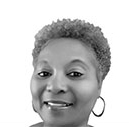
SHERRY CANNON
Patrice Cullors, Alicia Garza and Opal Tometi are the three African American women who founded Black Lives Matter in 2013 in response to the acquittal of George Zimmerman, the murderer of Trayvon Martin.
BLM vows to work toward a world where Black Lives are no longer systematically targeted for demise. Its mission is to eradicate white supremacy and to build local power to intervene in violence inflicted on Black communities by the state and vigilantes.
According to Jeffrey Robinson, ACLU’s Deputy Legal Director, although the Union won the Civil War, the Confederacy won the peace. It won the peace by rewriting the history of America.
The South has been very clever and intentional in changing the narrative. Terms like heritage is used instead of hate, or southern culture instead of slavery. We see it in the defense of the confederate flag or the monuments honoring traitors to this country. The top 10 states with Confederate monuments account for over 4,000 lynchings since the end of slavery.
In 1619, 20 human beings were brought to Jamestown, Va., and enslaved. From then until 1866, more than 12.5 million people were stolen from Africa and brought to the Americas. Almost two million died during the Middle Passage.
The enslavement of Black people made America rich. The free labor and the commodity of cotton created generational wealth for many white people and was the foundation of major American corporations and institutions.
In 1776, when this country was founded, 40 of the 56 signers of the Declaration of Independence owned other humans. Even the history of Abraham Lincoln being the “Great Emancipator” is distorted.
Lincoln’s goal was to preserve the Union, by any means necessary. One of his actual statements regarding slavery was, “If I could save the Union without freeing any slave I would do it, and if I could save it by freeing all the slaves I would do it; and if I could save it by freeing some and leaving others alone, I would also do that.”
Dr. Ibram X. Kendi, one of the leading voices on anti-racism, states, “We have been taught that ignorance and hate lead to racist ideas, lead to racist policies. The actual foundation of racism is not ignorance and hate, but self-interest, in particularly economic, political and cultural. When the policies are challenged because they produce inequalities, racist ideas spring up to justify those policies. Education, love and exemplary Black people will not deliver America from racism.”
Dr. Robin DiAngelo says we all have biases that are mostly implicit and unconscious; it’s when collective biases are backed by legal authority and institutional control, and are embedded in the media, religion, education, economics, and criminal justice system, then it becomes systemic.
Institutional power is the ability to disseminate your worldview to everyone and to shape how they see themselves, how they see you, and how they see themselves in relationship to you.
Dr. DiAngelo explains that institutional power is when one group’s experience is held up as universal. Legal authority and institutional control are what transform people’s prejudices into a far-reaching system. Racism is a system not an event.
Stacey Abrams makes it even clearer when she says we must understand that this power is not some benign system or structure, it is people. People who get to vote for laws, establish laws, sign laws, and enforce those laws.
White people don’t think of themselves in racial terms. When race is discussed it’s always someone else’s. There has never been a need for a white history month, or a white student union, or a white caucus. The culture has never questioned if white lives matter.
Carol Anderson, professor of African American Studies at Emory University, stated in an article in The Guardian, “In 1919, as soldiers returned from the first world war, many white Americans saw African-American men in military uniforms for the first time. That sight, and the challenge it posed to the political, social, and economic order, was deeply threatening to them. Groups of armed white men hunted down and slaughtered hundreds of Black Americans across the country. The wave of lynchings and race riots came to be known as the ‘Red Summer.’
“As in 1919, we are dealing with an America where Black and brown people must go into the streets to demand their rights because the institutions of democracy have failed to protect them. In 2020, we have a nation where large swaths of the executive, legislative and judicial branches at the federal and state levels have virtually abandoned millions of American citizens.”
We need more than statements of Black Lives Matters or marching with us in protest rallies. We have been waiting for 400 years for more allies willing to help us change the corrosive structure of this country.
As Nelson Mandela said, “May your choices reflect your hopes and not your fears.”

1 comment for “Real Talk | The Institutional Power of Whiteness”
Recent Comments